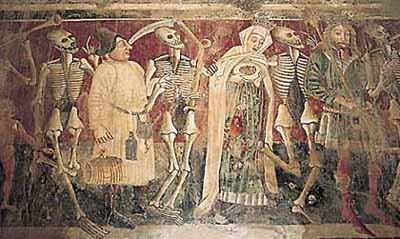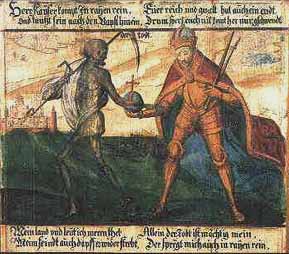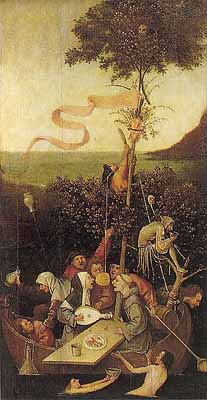When we - somewhat romantically - speak of the Renaissance we actually mean the period shifting from the Late Middle Ages (roughly 1300 to 1500) into the Early Modern period (roughly starting with the Age of Discoveries in the late 15. century).
In the idealized Italian view the Renaissance or 'Rinascita', which means rebirth, describes the rebirth of classical values that had been surpressed by mere barbarism for a thousand years. Roman art and culture had been pushed aside by allegedly ugly Gothic styles with sour looking, unattractive saints and statues. The antique Roman art that never really left the Italian mind would now florish again, humanists like Petrarch would breathe new life into dusted old scholasticism, new science would enlight mankind free of dogmatic shackles. This, as mentioned, is the idealized view that came closest to reality in the Italian cities of Florence and Siena.
However, in order to really understand the shades behind the Tarot trumps we should have a slightly closer look.
Prelude - the 14th century

Dance of Death
The late medievals up to the beginning of the 1300s have not been so 'dark' as popular belief suggests, on the contrary it had been a relatively prosperous and stable era (well, at least from a medieval viewpoint). The population of Europe had greatly increased, the socalled 'medieval warm period' had provided fair weather conditions with reliable crops and society had florished (again, medieval viewpoint..)
The Great Famine
The fourteenth century brought an end to all of that. The 'Little Ice Age' caused declining temperatures and bad weather, culminating in several years of cold and rain that ruined the crops and led to the Great Famine that roughly lasted from 1315 to 1320 and killed millions of people. When the rich had been able to cope the first one or two years their reserves ran out by 1317. From then on nobles, clergy and peasants suffered alike, the already fragile health status declined even further and diseases like pneumonia and tuberculosis claimed uncounted lifes.

The Black Death
The greatest disaster that struck already weakened 14th century Europe was the Black Death, the vast bubonic plague that ravaged throughout the continent from 1347 to 1351 cutting its population nearly to half - a tragedy of catastrophic proportions that we today could only imagine by figuring that all of a sudden 30 to 50% of all people around us suddenly fall ill with a horrible and disgusting, highly infectious disease and die.
The bubonic plague led to a vast economic depression due to the heavy loss of life and the
flight of whoever could afford it from the cities in which the plague was even more desastrous due
to the dense population and lack of hygiene. The panic and hysteria spreading through the
population can only be imagined though it had its ghastly witness when the panicked mob thought it
had spotted a possible cause for 'God's wrath' - a couple of Jews perhaps, some unfortunate Moorish
or simply a beggar or another hapless outsider.
After the worst was over in 1351 thew Black Death would continue to return every generation or so,
in minor waves even earlier (the next plague ravaging parts of Italy came in the 1360s), thus
becoming a dreadful but all too familiar compagnion of everyday life.
Embedded video: The Black Death AD 1347 (from the series 'History's Turning Points')

Battle of Crecy 1346
The Hundred Years War
And if all that hadn't been bad enough half of Western Europe was plunged in a war
that was to last for nearly hundred years.
Conflicts between France and England had aroused already in 1328 - in the wake of the Great Famine
- mainly over control of ressources in Flanders and its cloth industry and English attempts to
seize control over French land. Open war broke out in 1345, plunging both countries in turmoil and
greatly undermining people's trust in their leadership - when they were busy with their fighting
when their people needed them most. This led to peasants' revolts, endemic warfare and civil unrest
that even affected countries not directly involved in the French-English conflict.
The war lingered on and on and on with no end in sight and increasingly appearing like sheer
madness without rhyme or reason, devastating landscapes and peoples and repeatedly dragging
neighboring countries into its fatal ring of destruction.
The erosion of former structures
The fatal disasters of the 14th century thoroughly damaged the old structures that so long had provided the medieval life with familiar stability. There always had been three 'classes' - the aristocracy that fought and ruled, the 'middle class' comprising from traders and merchants, and the peasantry who produced food. Above it all resided the King and the clergy whose authority was rarely disputed. Even the poorest of the poor - including ca. 20% of the European population that comprised of homeless paupers - never put the existing society into serious question. In the undisturbed flow of daily life over generations and generations it simply had become normal.
This broad acceptance of presumed normality was utterly shattered. Both royalty and clergy had failed to provide any assistance or relief during the Great Famine or the Black Death, rather proven glaring incompetence and people lost their trust. The aristocracy was now as good as useless as a fighting power when the advent of fire-arms rendered their chivalry obsolete and rather called for standing armies of infantry soldiers. The knight in shining armour was a thing of the past and many aristocrats impoverished. The vast feudal possessions didn't survive the bloodloss of famines and plagues and were largely bought up by the few who had read the signs of the new rising capitalism in time. There were only two classes left defined by economic power - the haves and havenots.

Hieronymus Bosch: Ship of Fools
The Western Schism (1378-1415)
Rather comical but no less important in its influence was the Great Schism of the
Western Church, which in those days was all catholic (since protestantism had not yet evolved).
The farce began with the death of pope Gregory XI in 1378 when the cardinals were 'forced' to elect
an Italian pope for a change. Because since 1305 the papacy not only had moved to Avignon on
grounds that Rome was deemed unsafe, but every pope since then - seven altogether - had been a
French which didn't sit well with the Romans. To this add that the Avignon popes and their ilk had
been wallowing in lavish pomp and debauch to an extent that made the monarchs of the time look like
frugal ascetics (not that the Roman popes before had been much different..). Vowing betterment the
cardinals picked one Bartolomeo Prignano who soon reigned as Urban VI and moved the papacy back to
Rome.
The French cardinals had hoped to influence the new pope in their sense read interests but were
soon disappointed. Urban VI. proved to be stubborn and hot-tempered and even worse, he tried to
forbid cardinals to accept annuities from monarchs and other benefactors and insisted that the
Curia should do its administrative job without gifts and gratuities, condemning their lavish life
styles altogether.
Terrified, the Cardinals fled back to France and complained that Urban VI 'lacked Christian
gentleness and charity' and that he had an unreliable and violent character. They declared the
election illegal and pronounced a new pope, Clement VII.
Trouble was that Clement VII was not just an antipope put up by some rival factions - he was a
regularly elected legal pope. As was Urban VI. The Western church now had two popes, read two sole
and unique Vicars of Christ, two Bishops of Rome, two Supreme Pontiffs and two solitary
representatives of God on earth. Both of which declaring himself the only one and quickly
excommunicating the other. Both of which were, of course, infallible. Both of which maintaining
papal capitals which devoured staggering sums of money to be kept up, with both popes soon starting
to compete with each other in briberies, pomp, lavish gifts and bombast in order to win support.
Both of which thundering that only those are good Christians who would endorse him but everyone
endorsing the other or accept sacraments from the rival side would be heretic and could consider
himself excommunicated.
In those days excommunication was a serious matter, meaning as much as going straight to hell after
death to suffer unspeakable torment for all eternity. The firm belief in this concept was one of
the basic fundaments of Christian belief - and in extension the fundament of the Christian Church.
![]()
In a century already utterly shattered by death, hunger, poverty and war, stricken by famine and
plague, suffering from the rapid loss of stability and confidence, sinking into unprecedented
levels of violence and crime, this was the absolute last thing people could use.
The religious institution that should have spent at least solace and hope had come down to a sorry
and cynical farce. The church eventually resolved the two-popes-problem by 1415 but the loss of
trust and blind reliance in its moral authority was never made up for.
(to be continued)
Tarot di Mantegna - A journey through a Renaissance
deck![]()